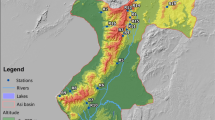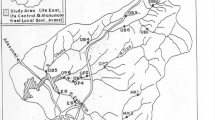Abstract
Data on the water chemical composition and species composition of periphyton algae have been analyzed in 25 rivers under different rates of anthropogenic impact in Primorskii krai, Russia. It is shown that chemical oxygen demand and the content of ammonium compounds of dissolved nitrogen are the most definite indicators of total anthropogenic impact. In the Razdol’naya River, which as the greatest anthropogenic eutrophication, it may be also indicated by organic compounds of dissolved phosphorus and nitrates. The number and biomass of periphyton algae varies considerably even within similar water streams. The alga species composition and the saprobity index calculated on its basis are more stable. The saprobity index is characterized by less spatial variability when compared to the chemical composition of river water. Nevertheless, there is a correlation between the saprobity index and the content of ammonium nitrogen, as well as between the saprobity index trend within the last 20 years and input of contaminants into the Razdol’naya River.
Similar content being viewed by others
References
Barinova, S.S., Medvedeva, L.A., and Anisimova, O.V., Bioraznoobrazie vodoroslei—indikatorov okruzhayushchei sredy (Biodiversity of Algae—Environmental Indicators), Tel Aviv: Pilies Studio, Russk. Izd., 2006.
Vodorosli: Spravochnik (Algae: A Handbook), Kiev: Nauk. Dumka, 1989.
Korde, N.V., The technique of biological study of bottom sediments of lakes (fieldwork and biological analysis), in Zhizn’ presnykh vod SSSR (Life of Freshwaters of the USSR), Moscow: Izd. AN SSSR, 1956, vol. 4, part 1, pp. 383–413.
Mnogoletnie dannye o rezhime i resursakh poverkhnostnykh vod sushi (Long-Term Data on the Regime and Resources of Surface Waters), Leningrad: Gidrometeoizdat, 1986, vol. 1.
Nikulina, T.V., Evaluation of the ecological state of the Razdol’naya River (Primorye, Russia) by the composition of indicator algal species, Vestn. DVO, 2006, no. 6, pp. 71–78.
Water quality standards for fishery water bodies, including the maximum permissible concentrations of harmful substances in water of fishery water bodies: Order no. 20 of the Federal Agency for Fisheries issued January 18, 2010, Ros. Gazeta, March 5, 2010.
Pomazkina, G.V. and Shcherbakova, T.A., Species composition of Bacillariophyta of the littoral zone of Lake Baikal (Russia), Algologiya, 2010, vol. 20, no. 4, pp. 449–463.
RD 52.18.595-96. Federal’nyi perechen’ metodik vypolneniya izmerenii, dopushchennykh k primeneniyu pri vypolnenii rabot v oblasti monitoringa zagryazneniya okruzhayushchei prirodnoi sredy (RD 52.18.595-96. Federal List of Measurement Techniques Allowed for Use in Monitoring Environmental Pollution), Moscow: Federal. Sluzhba Rossii po Gidrometeorologii i monitoringu okruzhayushchei sredy, 1996.
RD 52.24.564-96. Metod otsenki zagryaznennosti presnovodnykh ekosistem po pokazatelyam razvitiya fitoplanktonnykh soobshchestv Federal’noi sluzhboi Rossii po gidrometeorologii i monitoringu okruzhayushchei sredy (RD 52.24.564-96. The Method of Assessment of Pollution of Freshwater Ecosystems by the Indices of Development of Phytoplankton Communities by the Russian Federal Service for Hydrometeorology and Environmental Monitoring), Moscow: Gidrometeoizdat, 1996.
Rukovodstvo po gidrobiologicheskomu monitoringu presnovodnykh ekosistem (Guidelines for Hydrobiological Monitoring of Freshwater Ecosystem), St. Petersburg: Gidrometeoizdat, 1992.
Sladechek, V., General biological scheme of water quality, in Sanitarnaya i tekhnicheskaya gidrobiologiya: Mater. I s”ezda Vses. gidrobiol. obshch. (Sanitary and Technical Hydrobiology: Proc. I All-Union Congr. Hydrobiol. Soc.), Moscow: Nauka, 1967, pp. 26–31.
Unifitsirovannye metody issledovaniya kachestva vod (Standardized Methods for Study Water Quality), Part 3: Metody biologicheskogo analiza vod (Methods of Biological Water Analysis), Moscow: SEV, 1984.
Chislennost’ naseleniya Primorskogo kraya (The Population of Primorsky Krai), Vladivostok: Primorskstat, 2011.
Shul’kin, V.M., Bogdanova, N.N., and Perepelyatnikov, L.V., Space-time variations of river water chemistry in RF Southern Far East, Water Resour., 2009, vol. 36, no. 4, pp. 406–417.
Shulkin, V.M. and Semykina, G.I., Assessment of the impact of pollutants from land on the environmental problems of the Peter the Great Bay, in Sovremennoe ekologicheskoe sostoyanie zaliva Petra Velikogo Yaponskogo morya (CurrentEnvironmental State of the Peter the Great Bay, Sea of Japan), Vladivostok: Izd. Dom Dal’nevost. Fed. Univ., 2012, pp. 252–287.
Barinova, S.S., Anisimova, O.V., Nevo, E., et al., Diversity and ecology of algae from the Nahal Qishon River, northern Israel, Plant Biosyst., 2004, vol. 138, no. 3, pp. 245–259.
Barinova, S.S., Medvedeva, L.A., and Nevo, E., Regional influences on algal biodiversity in two polluted rivers of Eurasia (Rudnaya River, Russia, and Qishon River, Israel) by bioindication and canonical correspondence analysis (CCA), Appl. Ecol. Environ. Res., 2008, vol. 6, no. 4, pp. 29–59.
Besse-Lototskaya, A., Uncertainty in diatom assessment: sampling, identification and counting variation, Hydrobiologia, 2006, no. 566, pp. 247–260.
Blanco, S., Cejudo-Figueiras, C., Tudesque, L., et al., Are diatom diversity indices reliable monitoring metrics?, Hydrobiologia, 2012, no. 695, pp. 199–206.
Bukhtiyarova, L.N., Diatoms of Ukraine. Inland Waters, Kiev: Nat. Acad. Sci. Ukraine, Inst. Botan., 1999.
Chetelat, J., Pick, F.R., Morin, A., and Hamilton, P.B., Periphyton biomass and community composition in rivers of different nutrient status, Can. J. Fish. Aquat. Sci., 1999, vol. 56, pp. 560–569.
Kolkwitz, R. and Marsson, M., Ökologie der pflanzlichen saprobien, Ber. Dtsch. Bot. Ges., 1908, vol. 26, pp. 505–519.
Lavoie, I., Hamilton, P.B., Wang, Y.K., et al., A comparison of stream bioassessment in Quebec (Canada) using six European and North American diatom-based indices, Nova Hedwigia, 2009, vol. 135, pp. 37–56.
Li, S., Gu, S., Liu, W., et al., Water quality in relation to land use and land cover in the upper Han River Basin, China, Catena, 2008, vol. 75, pp. 216–222.
Marvan, P., Maršálek, B., Heteša, J., et al., Comments on the revised tables of algal (and other botanical) water quality indicators listed in CSN 75 7716—discussion material for assessment of trophic status of water bodies, 2005. http://www.cyanobacteria.net
Nikulina, T.V., Diatom flora of fresh and brackish water bodies of the Sakhalin Island (Far East, Russia), in Diatoms Diversity and Distribution, Role in Biotechnology and Environmental Impacts, New York: Nova Sci. Publ., 2013, pp. 35–86.
Pantle, F. and Buck, H., Die biologische überwachung der gewasser und die darstellung der ergebnisse, Gas- und Wasserfach, 1955, vol. 96, no. 18, p. 604.
Rimet, F., Recent views on river pollution and diatoms, Hydrobiologia, 2012, no. 683, pp. 1–24.
Shannon, C.B. and Weaver, W., The mathematical theory of communication. Urbana: Univ. Illinois Press, 1963, p. 345.
Sládeček, V., System of water quality from the biological point of view, Arch. Hydrobiol. Ergebn. Limnol., 1973, vol. 7, pp. 1–218.
Sládeček, V., Diatoms as indicators of organic pollution, Hydrochim., Hydrobiol, 1986, vol. 14, no. 5, pp. 555–566.
Van Dam, H., Mertens, A., and Sinkeldam, J., A Coded Checklist and Ecological Indicators Values of Freshwater Diatoms from the Netherlands, Netherlands J. Aquat. Ecol., 1994, vol. 28, no. 1, pp. 117–133.
Author information
Authors and Affiliations
Corresponding author
Additional information
Original Russian Text © V.M. Shulkin, T.V. Nikulina, 2015, published in Biologiya Vnutrennikh Vod, 2015, No. 1, pp. 19–29.
Rights and permissions
About this article
Cite this article
Shulkin, V.M., Nikulina, T.V. Comprehensive assessment of river-water quality in Primorskii krai, Russian Federation, with respect to chemical characteristics and composition of periphyton algae. Inland Water Biol 8, 15–24 (2015). https://doi.org/10.1134/S1995082915010149
Received:
Published:
Issue Date:
DOI: https://doi.org/10.1134/S1995082915010149




